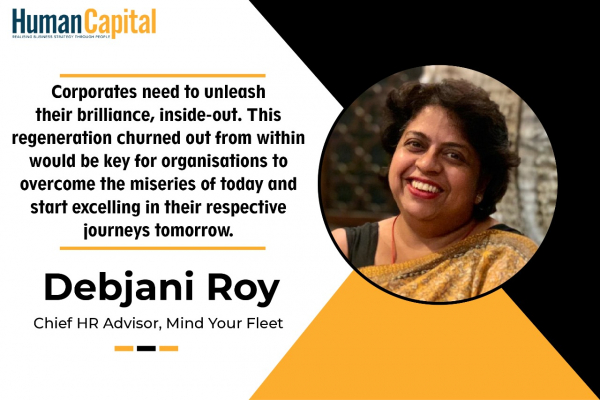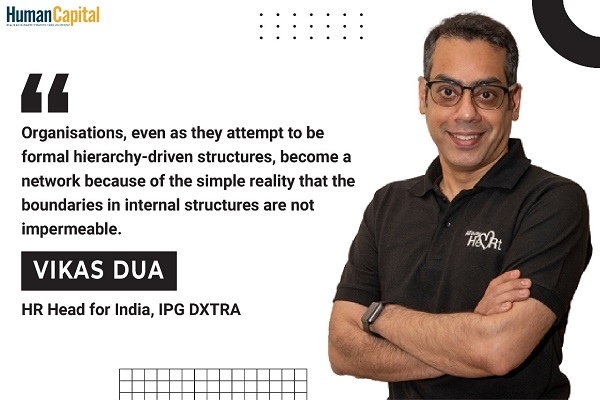Corporates need to unleash their brilliance, inside-out. This regeneration churned out from within would be key for organisations to overcome the miseries of today and start excelling in their respective journeys tomorrow.
My memories went back to the wet months of August-September last year – when life and its innumerable activities were pacing themselves in ways that seemed like a fairy tale as compared to where we are today. Like any other small city - news featuring in single columns in the International section of the regular news dailies in the country - the mention of a new virus suddenly gaining ground in a city named Wuhan was hardly noticed. Since then, it only took four months for this news snippet to emerge as the largest and the most unprecedented reality of modern times, sweeping the entire world in its fold. It was almost as if somebody had his/her life by the neck-hold - performed a surgery to remove some critical bones in a particular way – and gave a new twist and angle to it altogether.
And seven months later, COVID-19 has undoubtedly come about as the mainstay in 2020. As a word, ‘Pandemic’ has assumed a larger than life meaning with multiple generations being held in its grip. The fate of every animate and inanimate object and being, a part of the current eco-system on Earth seems altered, and in most cases, there is no clarity as to where and how.
I have been a Corporate animal for the most part of my life – and such unexpected and unprecedented circumstances continue to enthral and bother me at the same time. Like everything else, the Corporate has been impacted like never before - not in one or two ways, but on multiple fronts. Products and services that seemed to take 3–5 years to come within our grasp, were suddenly available at the doorstep. Newer ways of commerce were at work, with a completely different set of work priorities and a new language to speak! - changes that seemed to be knocking on the doors, asking to be examined ranged from Structures, the Workforce, Policies and frameworks, People skills and behaviours, Employee experiences, Welfare and Wellness etc. To say that this was mind boggling would be a mere understatement, and there was no way that this could be ignored.
The new-look Workforce deployment
The Pandemic has changed the very fabric of Workforce deployment and management across Corporates today.
With social distancing becoming the new normal, and concerns related to health and hygiene on top of everyone’s minds, remote working has come forth as the most preferred model of workforce deployment today.
Besides this, ‘GIG’ workers and ‘Digital Nomads’ – juggling multiple projects across numerous timelines and boundaries all at the same time - are also deployed in today’s workplaces. Such workforce elements are no longer expected to demonstrate the capabilities of employees of the pre-Pandemic era, but new skills and competencies to enable them to cope and succeed is the reality of the day.
Knowledge alone would have to be replaced with resilience, apart from continuity/longevity and adaptability. The hunger for learning will replace singleskill excellence and multi-skill orientation would come about as the order of the day. Above all, competencies like agility and critical thinking must be mastered in order to fit into a highly digitalised environment henceforth, apart from those that are rapidly innovating. This is likely to emerge as the next biggest change in the Corporate space.
The nimble, agile and innovative Organisation structures
As has been the case over several years in the past, Corporates have come to rally mostly around organic and traditional structures of hierarchy. Over a period of time, straight line hierarchies have gone ahead to innovate themselves into slightly different models like Matrix reportings, evolving span of controls, comparable org. charts etc.
The Pandemic and the sudden changes that have subsequently derived are now threatening age-old organisational structures, and are even forcing them down different paths - that of decentralised structures, dressing down of infrastructure per se, the move to more agile working etc. The reason behind all this is to encourage a high degree of autonomy for people at the fringes to make decisions, innovate, and get things done. It could also result in a high degree of alignment across groups to facilitate proper working all along.
The above is being particularly affected since organisations that are traditionally structured are suddenly finding the current environment – that of flux, chaos and new norms - increasingly challenging. Business functioning is under tremendous stress, with people getting stretched in different directions, resulting in the collapse of authority structures. The future, therefore, would belong to new-look structures that would be nimble, agile and quick to better respond to external as well as internal developments. Hence, we are witnessing structures, and terms like the ‘Helix’, ‘Warrooms’, ‘Nerve-rooms’ are being inter-changeably used while describing new Org. structures coming in place all of a sudden. Crack teams from amongst the current workforce would be deployed through these new formations to provide rapid and realtime responses on a continuous basis in the face of the fastchanging business landscape. What will, however, be the test of time is in seeing how well traditional organisations can overcome their earlier structural inertia and adapt to newer ways of doing work.
One would therefore not be wrong to say that the future will see most Corporates functioning differently. They will be seen moving away from the old-fashioned top down linear structure or teams functioning around departmental hierarchies, towards more modular units created around different skill-sets, coming together to complete a project, and then being disbanded. This would allow grouping, dispersing and re-grouping faster, and thereby enable quick decision-making. Faster decisionmaking will, in turn, allow the Corporate to take advantage of fast-changing landscapes and opportunities in a seamless manner.
A paradigm shift in Employee Experience
The physicality associated with the workforce of yesteryears is a thing of the past today. It will not only be a ‘pun’ to say that the Pandemic has dealt a body-blow to the same. Hence, the rules of the game for creating an enabling environment for employees at the workplace are drastically challenged, posing sleepless nights to Managers and HR alike. After all, a solid physical property – the workforce – does not always vanish overnight!
This shift, therefore, has to be understood from two point of views that are almost diametrically opposite – both, however, being today’s realities for the employees. On the one hand, there is insecurity and anguish that has been brought along by the pandemic, forcing people to shift from age-old habits and comfort zones. Whatever the odds, the office is looked upon as a great ‘equal’, a strong socialising influence on multiple people – who get together regularly sharing a common identity (that of the company) and spend a fair amount of quality time together. Work was always welcome, and more so, the money one received for it at the end of the month. All of a sudden, this has changed. Many stopped coming to offices overnight, and some were also told not to work from home since they had been laid-off. This was owing to the turmoil in the economy and the Company being unable to cope with it immediately. For those losing their jobs, it was no less than a catastrophe that had suddenly fallen.
On the other hand, many were working from home, but a sudden alienation and disarray had no less struck them because of the changing norms of work that needed getting used to. To make matters worse, traditional styles of leading the Teams by the Managers/Leaders in a completely altered reality were not making things any easier. Working hours often got extended beyond normal, the fine line between home and office continued to get blurred, the home environment comprehensively got affected for the worse (with children being the biggest sufferers), mental wellbeing was challenged, and the overall balance was lost.
This was primarily a fall-out of the inability of managers and leaders to upskill themselves in sync with the Pandemic to understand the sensitivities of how to extract work from a workforce that was already shaken under extra-ordinary circumstances. A supportive learning environment was needed to be in place to prepare supervisors with the required skills to take on the new reality that has been severely compromised. Even today, the learning is slow, and the challenges of sustaining the right levels of efficiencies and productivity from a remote workforce are bothering Corporates to no end.
A new language for a new-kind of work-place
Becoming future-fit today - in light of all that has been described above – will need much more than just incremental improvements in certain areas. It would be nothing less than attempting a ‘restructuring effort’, applying principles of design thinking, agile management, focussed and reinforced learning, employee wellbeing, and longterm sustainability. Underlying all the above would be the need to unlearn, learn and recreate a platform that will have renewed skilling, developing managerial competence, getting the work-life balance right and employing empathy as its pillars. Only then can new systems and processes be designed for the newlook workplaces that would see them through such difficult times and build sustainability where required.
It is uncertain as to when the Pandemic will recede and where will things be pointing while moving towards the erstwhile normal, and how would tomorrow’s workplace look like. Would it be an absolute case of remote working or would it be back to the office for most? It seems reasonably certain that most organisations have found benefits in having their back-end services personnel work from home. While this has raised the efficiency levels, it has also resulted in cost savings. And for employees – saving travel time, avoiding extreme physical exhaustion, reasonable cost savings, and more time at home have been some of the positive payoffs. Despite this, it appears as reasonably certain that there will no going back to the original ways of working of the preCOVID times. Nor are we envisaging doing away with office spaces completely. A hybrid version is probably what looks most probable, and that is what would need to become future-fit today.
Some key initiatives to be future-fit would include:
♦ Lending a greater vision to the current workforce: To help reinstate their feelings of trust and faith in the Corporate. This is crucial especially when the going gets tough and there is a sense of disarray all around. The morale of the employee plays tricks upon him and that is when the rejuvenation must be done. It needs to be treated almost like a rehab centre – cleansing and reinforcing both at the same time.
♦ Create an enabling environment for employees: Future-fit organisations will have to strike a steady balance between productivity and employee wellness. Work under new conditions would present challenges - not experienced earlier which could lead to higher degrees of stress and pain – that which have been mentioned earlier. Hence, this would undoubtedly be a crucial factor in becoming futurefit. Also, employee wellness from here onwards would be a business prerogative (no less), and would therefore be the responsibility of all stakeholders.
♦ Upskilling and Reskilling across the Organisation: This would become a mandate from here onwards and new competencies would have to be mastered. ‘Continuous Learning’ of different kinds would become a critical success factor for Corporates in their journey ahead from here. And both push and pull would be at work to create the right knowledge and skill groups.
♦ New ways of Leadership: New ways of managing and new ways of supervision would come into play. Leading remote teams and forging performance synergies between the remote and the ones working in offices would present new opportunities as well as new challenges. Leaders would have to learn how to lead in the new normal, while efficiencies and productivity are not compromised. Performance Metrics would have to be redefined, while the output would be key, rather than presence/ physicality.
♦ Putting in place open & live communication channels for all: To create a transparent and real-time workplace. This could very well play the role of a catalyst in treating insecurities borne out of the new normal workplace and stresses contained therein.
As is apparent now, Corporates need to unleash their brilliance, inside-out. This regeneration, churned out from within would be key for Organisations to overcome the miseries of today and start excelling in their respective journeys tomorrow.

Are you comfortable working with dispersed colleagues?
Trending
-
SBI General Insurance Launches Digital Health Campaign
-
CredR Rolls Out 'Life Happens' Leave For Its Employees
-
Meesho Announces 30-Week Gender-Neutral Parental Leave Policy
-
Microsoft Unveils Tech Resilience Curriculum To Foster An Inclusive Future
-
60% Indian Professionals Looking For Job Change Due To COVID: Survey
-
SpringPeople And Siemens Collaborate For Digital Transformation Push
-
86% Professionals Believe Hybrid Work Is Essential For Work Life Balance: Report
-
Almost 1 In Every 3 People's Personal Life Affected Due To Work Stress
-
Meesho Rolls Out Reset And Recharge Policy For Employees
-
80% Of Talent Leaders & Academics Say Pandemic Changed Skill Needs For Youth: Report
-
Hero Electric Rolls Out 'Hero Care' Program For Employees
-
Human Capital In Collaboration With ASSOCHAM Hosts Virtual Conference
-
IKEA India, Tata STRIVE Collaborate To Create Employability And Entrepreneurship Opportunities
-
SAP India, Microsoft Launch Tech Skilling Program for Young Women
-
DXC Technology, NASSCOM Collaborate For Employability Skills Program
-
Lenskart To Hire Over 2000 Employees Across India By 2022
-
Mindtree Launches Learn-and-Earn Program
-
Tata AIA Extends 'Raksha Ka Teeka' To Its Employees
-
Swadesh Behera Is The New CPO Of Titan
-
NetConnect Global Plans To Recruit 5000 Tech Professionals In India
-
Hubhopper Plans To Hire 60% Of Indian Podcasters By 2022
-
Corporate India Needs More Women In Leadership Roles: Report
-
Aon to Invest $30 Million and Create 10,000 Apprenticeships by 2030
-
Tech Mahindra Launches ‘Gift a Career’ Initiative for Upskilling of Youth
-
40% Women Prefer Flexible Working Options in Post-COVID World: Survey
-
3 out of 4 companies believe they can effectively hire employees virtually: Report
-
Vodafone , CGI and NASSCOM Foundation launch digital skills platform
-
Odisha: Bank, postal employees to deliver cash for elderly, differently-abled persons
-
Skill India launches AI-based digital platform for "Skilled Workforce"
-
Hiring activity declines 6.73% in first quarter: Survey
-
70% startups impacted by COVID-19 pandemic
-
Bajaj Allianz Life ropes in Santanu Banerjee as CHRO
-
Over 70 Percent MSMEs look at cutting jobs to sustain businesses
-
93 Per Cent employees stressed about returning to office post-lockdown
-
Johnson & Johnson India announces family benefits for same gender partners
-
Indian firms turning friendly towards working mothers
-
Welspun India names Rajendra Mehta as new CHRO
-
Wipro partners with NASSCOM to launch Future Skills platform



Human Capital is niche media organisation for HR and Corporate. Our aim is to create an outstanding user experience for all our clients, readers, employers and employees through inspiring, industry-leading content pieces in the form of case studies, analysis, expert reports, authored articles and blogs. We cover topics such as talent acquisition, learning and development, diversity and inclusion, leadership, compensation, recruitment and many more.
Subscribe Now












































Comment